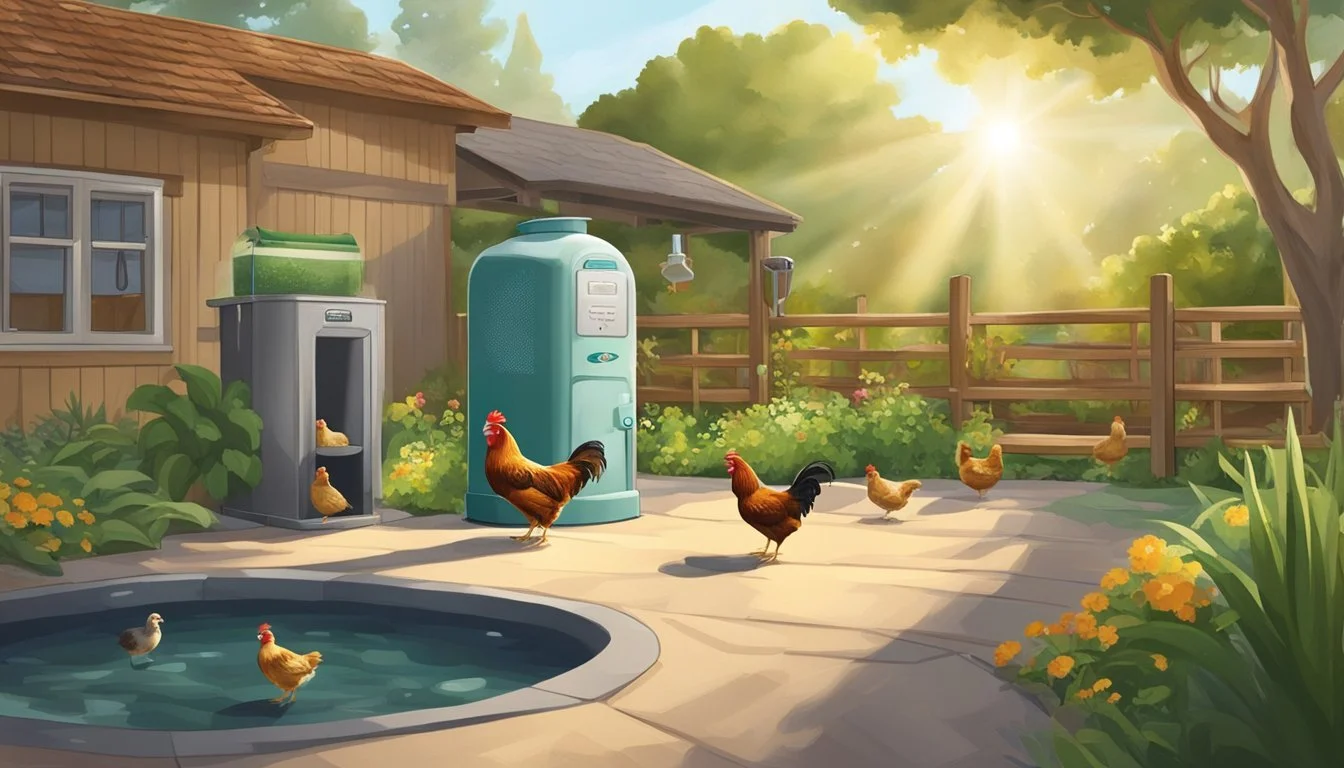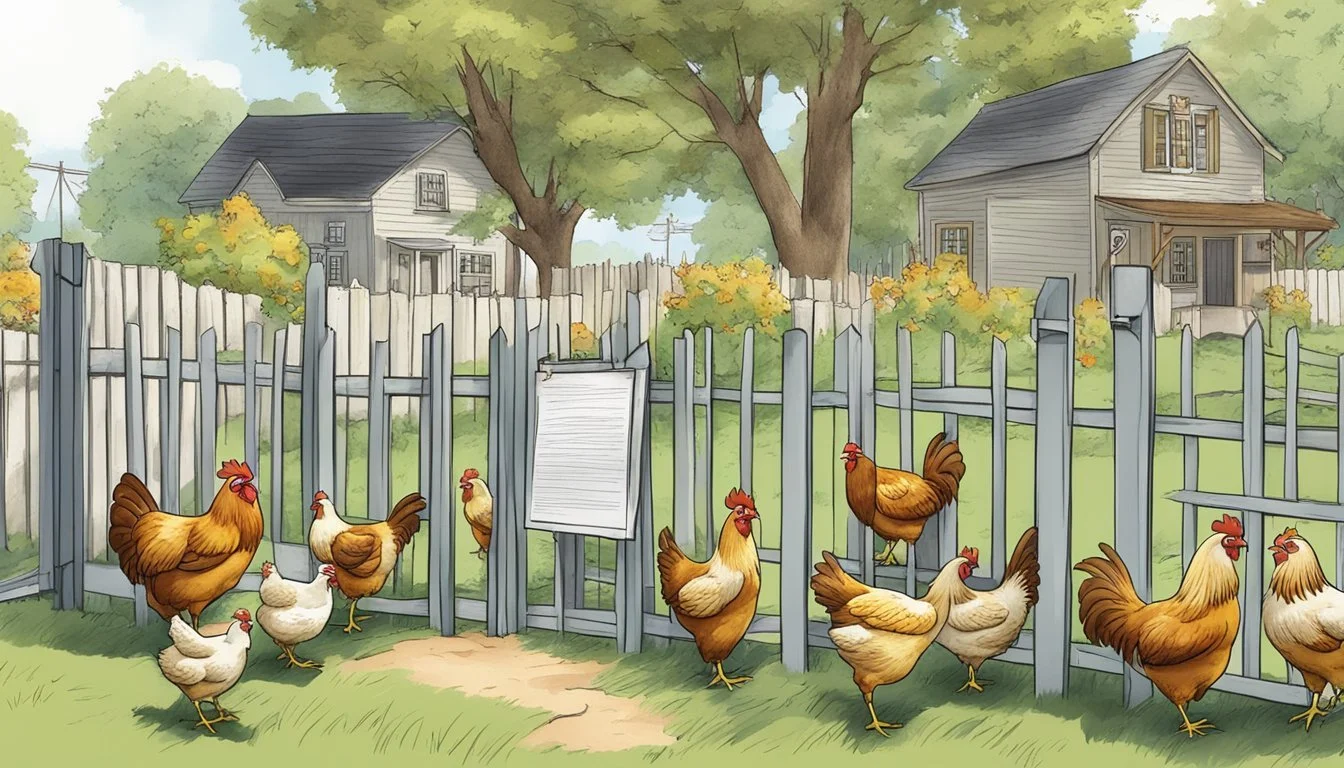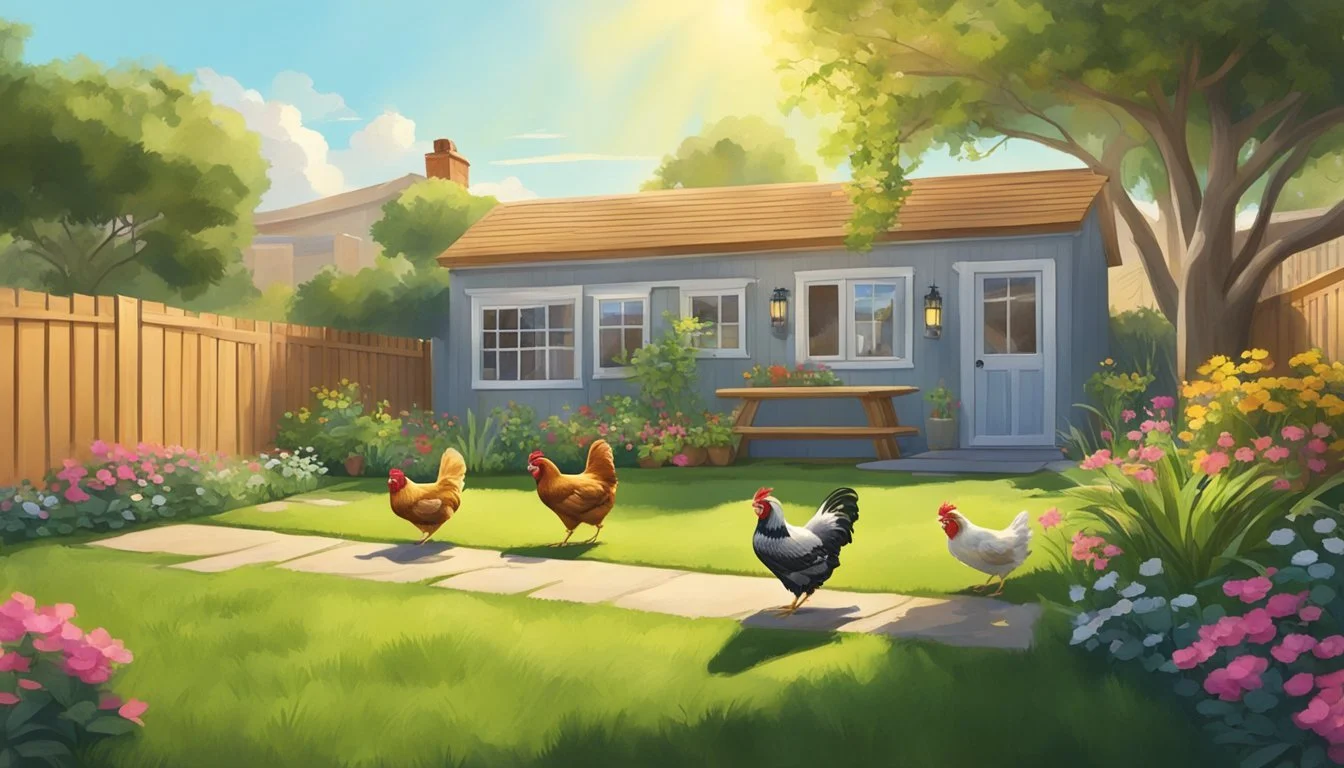Keeping Backyard Chickens in Chula Vista, CA
Essential Tips for Urban Poultry Farming
Keeping backyard chickens has become a popular endeavor for many who seek the rewards of fresh eggs and the simple pleasures of caring for poultry. In Chula Vista, California, residents considering this venture must navigate a series of local regulations that govern the keeping of chickens and other fowl. These laws ensure that the activity fits within the community's standards and respects the well-being of the animals as well as the neighbors' right to quiet enjoyment of their property.
Chula Vista's specific ordinances address several aspects of backyard chicken keeping. The lot size of the property is a considerable factor, as space and distance requirements from neighboring dwellings are stipulated by local law. While the city does enforce strict measures to regulate the keeping of chickens, prospective poultry owners are also encouraged to familiarize themselves with broader state regulations that can affect their backyard chicken activities.
Understanding Local Chicken Laws
In Chula Vista, California, residents are subject to specific local ordinances governing the keeping of backyard chickens. These regulations are designed to ensure the welfare of the chickens, as well as the comfort and safety of the community.
Overview of Chula Vista Zoning Ordinances
Zoning ordinances in Chula Vista allow residential properties to keep backyard chickens under certain conditions. These conditions include adherence to space requirements and maintaining the cleanliness and orderliness of the premises to prevent nuisances. Potential chicken keepers should consult the Chula Vista Municipal Code and any specific local zoning regulations relevant to their residential area to ensure compliance.
Permit Requirements for Keeping Chickens
Chula Vista does not generally require permits for keeping backyard chickens if the number of chickens does not exceed the specified limit. However, residents must be aware of the space requirements stipulated by local laws. A permit might be necessary if the number of chickens exceeds the set limit or if other types of fowl are to be kept alongside chickens.
Restrictions on Number and Type of Chickens
In Chula Vista, the law permits up to six chickens on a residential property without the need for a specific permit. The property must have a minimum of 7,000 square feet to house this number of chickens.
Number and Type of Fowl Space Requirement Up to 6 chickens 7,000 sq ft
The city imposes strict regulations on the types of chickens and the numbers allowed. More exotic fowl or larger numbers may be subject to additional restrictions. The City of San Diego’s regulations should be referenced for residents in the larger San Diego area, as they may differ from Chula Vista’s local regulations.
Setting Up Your Chicken Coop
Setting up a chicken coop properly in Chula Vista is critical for the welfare of your backyard chickens. It involves picking an ideal spot, ensuring protection from predators, and establishing routines for maintenance and hygiene.
Choosing the Right Location
The location of your chicken coop in your backyard should comply with local ordinances. In Chula Vista, the coop must have a minimum of 7,000 square feet of tract land to house chickens. It should be positioned away from property lines, respecting setback requirements, to minimize any disturbance to neighbors. The coop should ideally be placed in a part of the rear yard that is well-drained to avoid water accumulation and to ensure the health and comfort of both hens and roosters.
Designing a Predator-proof Chicken Coop
A predator-proof chicken coop is essential to safeguard your chickens from potential threats such as raccoons and hawks. The enclosure should be constructed with hardware cloth rather than chicken wire, as the latter can be easily compromised. All access points should have secure latches, and consider burying the perimeter of the enclosure to deter digging predators. The coop must be ventilated to provide fresh air but must also be watertight to keep the interior dry.
Coop Maintenance and Hygiene
Regular maintenance is crucial to keep the coop a healthy environment. The nesting boxes and areas where chickens roost need to be cleaned out to prevent accumulation of waste, which can lead to disease. Feeders and water dispensers must be accessed regularly to refill and clean, maintaining a hygienic space for the chickens to eat and drink. Establishing a routine for coop cleanliness, including frequent inspection and repair of the structure, will ensure the coop remains safe and comfortable for your chickens.
Caring for Your Flock
When raising chickens in Chula Vista, CA, owners must be diligent about daily care routines, health and safety measures, and proper feeding and nutrition to ensure the well-being of their flock.
Daily Care Routines
Every day, caregivers must check on their flock to ensure that each chicken has access to clean water and feed. Coops need regular cleaning to prevent the build-up of waste and to reduce the risk of disease. Chickens should be let out into a secure area for exercise and foraging to maintain their physical health and natural behaviors.
Health and Safety Measures
Chickens require protection from predators and should be housed in a secure coop, especially at night. Regular health checks are essential to catch potential issues early, looking out for signs of distress, injury, or illness. It's equally important to keep the environment free of toxic plants or substances that could harm the animals. An emergency plan should be in place in case of outbreaks of diseases like avian influenza.
Feeding and Nutrition
Chickens thrive on a balanced diet consisting of:
Layer pellets or crumbles: Specially formulated for egg-laying hens.
Grit: Helps with digestion.
Calcium supplements: Such as oyster shell, for strong egg shells.
They should always have access to fresh, clean water. Treats like vegetables, fruits, and grains can be given in moderation, but should never replace their main diet. Proper nutrition is critical for the health and productivity of the flock.
Neighborhood Relations and Legal Considerations
When raising backyard chickens in Chula Vista, CA, residents must consider both neighbor relations and adherence to local regulations. The success of a backyard coop often hinges on maintaining a good rapport with neighbors and ensuring compliance with city ordinances.
Navigating Neighbor Concerns
Neighbors can have concerns about backyard chickens, such as noise, odors, or pests. Chula Vista Municipal Code allows a certain number of chickens on residential properties, but residents must consider their neighbors' peace and property enjoyment. Open communication and cooperative management of the backyard flock can address these concerns effectively.
Discuss plans for a chicken coop with neighbors to foster understanding.
Mitigate potential issues like noise by keeping roosters—which are typically louder than hens—off the property.
Implement waste management strategies to control odors and pests.
Compliance with Property Regulations
Residents must navigate a variety of local ordinances when keeping chickens in residential areas. Chula Vista stipulates that on tracts of land with a minimum of 7,000 square feet, one can keep up to six chickens, provided there is no more than one dwelling unit on the property.
Review Chula Vista Municipal Code 6.04.080 for specific poultry limitations and combinations.
Ensure the chicken coop and run adhere to property line setbacks and do not violate any restrictions posed by homeowners associations (HOAs) or other neighborhood governance structures.
Understanding and adhering to these regulations and fostering positive neighbor relations are key to responsibly and legally keeping backyard chickens in Chula Vista, CA.
Benefits of Backyard Chickens
Backyard chickens in Chula Vista provide residents with tangible benefits, ranging from nutritional advantages to positive environmental impacts.
Fresh Eggs and Nutrition
Backyard eggs offer superior nutrition compared to many store-bought varieties. They are often richer in vitamin E and vitamin A, as well as beta carotene, which contributes to their deep orange yolks. The chickens' diet of insects and garden scraps, in addition to their feed, elevates the nutritional content of their eggs. It's common for families to notice a vibrant color and a more robust flavor in the eggs from their backyard flocks.
Environmental Advantages of Raising Chickens
Maintaining a backyard flock contributes to lower carbon emissions by reducing the need for transportation of store-bought eggs. Additionally, chickens aid in waste reduction by consuming food scraps and provide valuable fertilizer through their manure. This natural fertilizer is rich in nitrogen, aiding garden health and growth without the use of chemical alternatives.
Waste Management and Sustainability
Managing waste effectively and harnessing its potential for sustainability are central to keeping backyard chickens in Chula Vista, California. Through proper waste management techniques such as composting chicken manure and incorporating kitchen scraps, residents can markedly reduce household waste and contribute positively to the environment.
Composting Chicken Manure
Chicken manure is a valuable by-product of backyard chickens that can be transformed into a rich fertilizer through composting. It's essential for chicken owners to develop a compost pile system that allows the manure to decompose appropriately, ensuring that the transformation from raw excrement to nutrient-rich compost is efficient. The City of Chula Vista’s Office of Sustainability recommends a composting process as a sustainable practice for managing chicken waste.
Benefits:
Provides a use for chicken waste
Enhances soil fertility
Incorporating Leftover Kitchen Scraps
Chula Vista residents can further promote sustainability by incorporating kitchen scraps into their chicken's diet. This process not only reduces food waste but also adds variety to the chickens' diet. The Development Services Department may provide guidance on what leftovers are safe for chicken consumption, as certain foods may be harmful.
Examples of Safe Scraps:
Vegetable peels
Fruit remnants
Reducing Household Waste
By integrating these practices, households can significantly reduce the amount of organic waste entering landfills. Chicken owners become an active part of the clean and sustainable lifestyle promoted by Chula Vista. Recycling kitchen waste through their chickens and converting chicken manure into compost for gardens are simple yet powerful steps toward environmental responsibility.
Impact:
Diminishes landfill contributions
Encourages a closed-loop system within the home
Additional Considerations
In the pursuit of maintaining a harmonious backyard chicken habitat in Chula Vista, CA, residents must consider the diversity of allowable livestock as well as valuable insights gained from community experiences.
Backyard Livestock Diversity
Chula Vista permits a variety of backyard livestock, subject to specific regulations that ensure proper space and care for the animals. Chickens are a popular choice, with the city's municipal code allowing for up to six chickens per household. However, residents can also opt for other poultry or small livestock. The legal combination includes up to:
Six rabbits
Two turkeys
Two ducks
Two geese
Ten pigeons
The overall limit is a maximum of 25 animals per tract of land, provided the family lives on a minimum of 7,000 square feet. This diversity offers residents in Chula Vista, and by extension, those in the broader San Diego County, the opportunity to explore urban homesteading with an array of animals, beyond solely raising chickens.
Learning from Community Experiences
Community forums such as BackyardChickens.com serve as a valuable hub for sharing insights and experiences. Regional threads, like those focused on San Diego or even broader ones like California, cover a vast array of topics where Chula Vista inhabitants can learn from others in Los Angeles, San Francisco, Sacramento, and even rural areas of the state. They might discuss the best practices for coop construction, navigating local regulations efficiently, and addressing common challenges with predators or diseases.
One crucial recommendation residents often encounter is to engage with local community resources. Be it a neighbor in Eastlake, a local urban farming group in Oakland, or an agricultural extension office in Bakersfield, a wealth of knowledge is always available. These resources can guide new and experienced chicken keepers alike in establishing a thriving backyard flock that aligns with municipal codes and respects the nuances of urban farming within Californian cities.
Resolving Legal Challenges
When keeping backyard chickens in Chula Vista, CA, residents must navigate municipal codes and possible legal disputes with confidence and clarity. Understanding local regulations and taking proactive steps to comply can forestall legal challenges and ensure a harmonious community coexistence.
Understanding Municipal Code Amendments
City of San Diego Municipal Codes stipulate precise regulations for keeping domestic fowl. In Chula Vista, they may keep up to six chickens on a single tract of land, provided the lot is at least 7,000 square feet. It's critical for residents to regularly review and comprehend these municipal codes, as amendments may alter permissible quantities or introduce new zoning setbacks.
To maintain compliance, individuals should:
Regularly check the Chula Vista Municipal Code, Section 6.04.080.
Understand the specific zoning regulations affecting their property.
Confirm that their property meets zoning setback requirements.
Proactively Addressing Legal Disputes
Residents may face challenges from neighbors or the city itself regarding their chickens. It is essential to handle these disputes proactively to maintain a legal standing. Before acquiring chickens, engagement with neighbors and securing written approval when necessary can prevent future disputes. Additionally, registering poultry with the city planning and zoning departments helps demonstrate a resident's intent to stay within the legal framework.
If residents encounter legal issues, they should consider the following steps:
Review their compliance with municipal codes and zoning regulations.
Engage in open dialogue with any concerned parties.
Seek legal advice if necessary to resolve disputes favorably.
By staying informed and engaging with the community, Chula Vista residents can enjoy the benefits of backyard chickens while abiding by the law.
Conclusion
In Chula Vista, backyard chicken keeping is feasible, provided residents adhere to local regulations. Property size plays a significant role, as does the importance of maintaining a safe distance from neighboring homes. While quail (What wine goes well with quail?) are not explicitly mentioned in the city's laws, they are likely classified alongside domestic fowl, which have clear guidelines regarding quantity.
Health considerations cannot be overstated—chickens may harbor diseases such as Salmonella. Therefore, practicing stringent hygiene is imperative for keepers. California laws additionally mandate against neglect and animal mistreatment, with serious ramifications for those found non-compliant.
The City of San Diego allows up to five chickens in single-family detached homes, revealing a trend towards more urban homesteading. Chula Vista residents would do well to examine closely both state and municipal codes before embarking on chicken ownership.
Listed below are essentials for prospective owners in Chula Vista:
Ensure property size meets regulation standards.
Position coops to respect the 50-foot distance rule.
Familiarize oneself with both state and local laws.
Exercise good hygiene to prevent disease transmission.
Understand the legal consequences of neglect.
For a rewarding experience with backyard chickens, compliance with these guidelines is quintessential. It is not only about observing the letter of the law but also about fostering responsible and harmonious urban agriculture practices.









